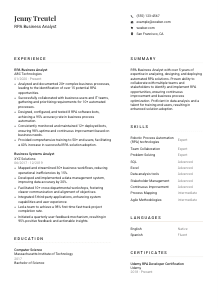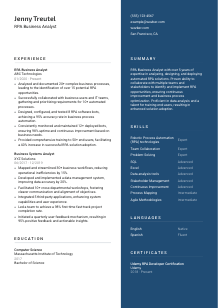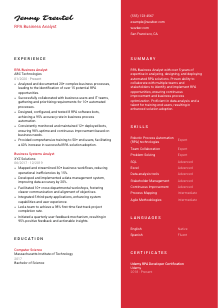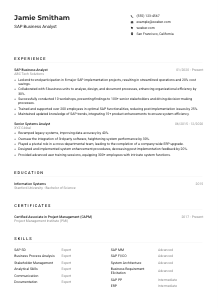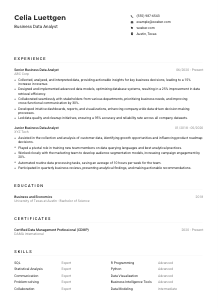RPA Business Analyst Resume Example
Aligning automation flows, but your resume feels stuck in a loop? Navigate this RPA Business Analyst resume example, created with Wozber free resume builder. Learn how to integrate your analysis acumen with robotic process potential, ensuring your career advances as seamlessly as the workflows you design!
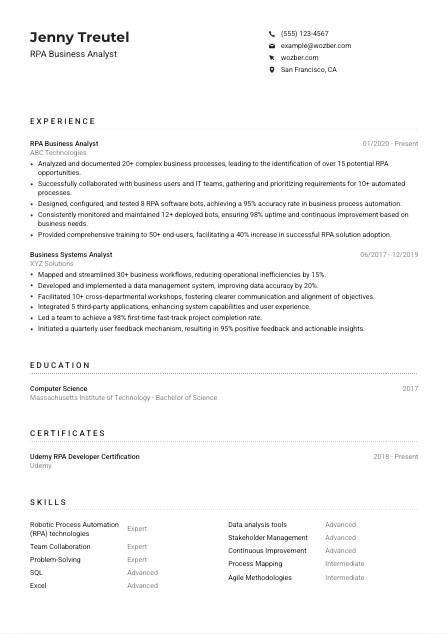
How to write a RPA Business Analyst resume?
Embarking on the journey to land your dream RPA Business Analyst role? Your resume is the first step in showing potential employers that you're the perfect fit for their team. With the evolving job market and the advent of Applicant Tracking Systems (ATS), crafting a resume that stands out has become crucial. Fear not!
With Wozber's free resume builder, ATS-friendly resume templates, and dedicated ATS resume scanner, you're about to create a resume that not only ticks all the boxes but also captures the essence of what it means to excel as an RPA Business Analyst. Let's dive into how you can tailor your resume specifically for this role, making it resonate with both human recruiters and digital gatekeepers alike.
Personal Details
Your resume's personal details section is more than just a formality—it's the gateway to your professional persona. Tailoring this section for an RPA Business Analyst position ensures you're speaking directly to what the employer is seeking, right from the start.
1. Your Name as Your Brand
Your name is the beacon that guides the hiring manager through your professional landscape. Make it prominent. Use a clear, legible font and consider setting it apart with a slightly larger size to ensure it catches the eye.
2. Job Title Alignment
Directly beneath your name, align yourself with the role by listing it. Including "RPA Business Analyst" as your title immediately signals to the hiring manager and the ATS that your profile is relevant to the job posting.
3. Essential Contact Information
Your contact details should be straightforward and professional. Double-check your phone number for accuracy, and use an email format that is professional (e.g., firstname.lastname@email.com). This is not the place for quirky handles or outdated contacts.
4. Locational Advantage
Since the job specifies a location in San Francisco, CA, make sure to list your city and state prominently. This assures potential employers that you are either local or ready to relocate, ticking an essential box in the preliminary criteria.
5. Online Professional Presence
If you have a LinkedIn profile or a professional website, include it. Ensuring your online professional presence is aligned with your resume offers a cohesive image of your professional brand. Just make sure it's scrubbed and presents you in the best light possible.
Takeaway
Crafting a professional and polished Personal Details section sets the tone for the rest of your resume. It's your first opportunity to communicate your alignment with the RPA Business Analyst role, ensuring you're not lost in the shuffle. Keep it neat, relevant, and aligned with the job's geographical and professional requirements.





Experience
The Experience section is where you turn the spotlight onto your journey as an RPA Business Analyst. By meticulously aligning your past roles with the job's needs, you demonstrate to hiring managers and the ATS that your background is not just relevant, but exceptionally suited for the position.
- Analyzed and documented 20+ complex business processes, leading to the identification of over 15 potential RPA opportunities.
- Successfully collaborated with business users and IT teams, gathering and prioritizing requirements for 10+ automated processes.
- Designed, configured, and tested 8 RPA software bots, achieving a 95% accuracy rate in business process automation.
- Consistently monitored and maintained 12+ deployed bots, ensuring 98% uptime and continuous improvement based on business needs.
- Provided comprehensive training to 50+ end‑users, facilitating a 40% increase in successful RPA solution adoption.
- Mapped and streamlined 30+ business workflows, reducing operational inefficiencies by 15%.
- Developed and implemented a data management system, improving data accuracy by 20%.
- Facilitated 10+ cross‑departmental workshops, fostering clearer communication and alignment of objectives.
- Integrated 5 third‑party applications, enhancing system capabilities and user experience.
- Led a team to achieve a 98% first‑time fast‑track project completion rate.
- Initiated a quarterly user feedback mechanism, resulting in 95% positive feedback and actionable insights.
1. Breakdown and Align
Initiate by mapping out the job's requirements. For instance, the job demands experience with 'analyzing and documenting business processes'. Highlight your achievements in these areas, such as 'Analyzed and documented 20+ complex business processes, leading to the identification of over 15 potential RPA opportunities'.
2. Structure Your Narrative
Organize your experience in reverse chronological order, starting with your most recent position. Clearly state your job title, the company's name, and the period of your employment. This structure aids in building a clear timeline of your professional growth.
3. Accomplishments Over Tasks
Instead of listing daily tasks, focus on your accomplishments. For each role, articulate how you've contributed positively, incorporating quantifiable results wherever possible. For instance, 'Designed, configured, and tested 8 RPA software bots, achieving a 95% accuracy rate in business process automation'.
4. Quantifiable Success
Numbers speak volumes. They provide concrete evidence of your impact and capabilities. Whether it's the number of bots you've deployed, the percentage of process efficiencies you've achieved, or the scale of the training sessions you've led—quantify your contributions.
5. Relevance is Key
Filter your experience to focus solely on the roles and achievements that directly align with the RPA Business Analyst position. Irrelevant experiences can detract from the strength of your application, so curate your history to showcase your suitability for this specific role.
Takeaway
The Experience section is your opportunity to demonstrate that you're not just qualified but unparalleled for the RPA Business Analyst role. By tailoring your professional history to the job's requirements and highlighting your tangible contributions, you position yourself as an indispensable asset. Let your experiences tell the story of an adept analyst equipped to advance any team's RPA objectives.
Education
In the realm of RPA Business Analysis, your educational background forms the backbone of your expertise. Tailoring this section to reflect the job's specific educational prerequisites enhances the narrative of your preparedness and alignment with the role's demands.
1. Identify Key Requirements
Foremost, discern the precise educational credentials the job listing emphasizes. Notably, for this role, a 'Bachelor's degree in Computer Science, Information Systems, or a related field' is a fundamental requirement.
2. Present with Clarity
Simplicity aids clarity. List your degree, the field of study, your university or institution, and your graduation year in a straightforward format. This unambiguous presentation ensures that this critical information is easily accessible to the ATS and hiring managers.
3. Tailor Degree Details
If your degree precisely matches the job criteria, such as a 'Bachelor of Science in Computer Science', highlight it prominently. In the event of multiple degrees or specializations, prioritize the one most relevant to the RPA Business Analyst role.
4. Spotlight Relevant Courses
Though not always necessary, detailing pertinent courses can be particularly beneficial if you're early in your career or if the role is specialized. Courses related to RPA, analytics, or system design can underscore your readiness for this specific position.
5. Showcase Educational Achievements
Related achievements, such as honors, significant projects, or extracurricular involvement, can further illustrate your dedication and capability in your field. However, weigh the relevance of these details considering the seniority level of the role you're applying for.
Takeaway
Your education section is more than a list of qualifications—it's a testament to your foundational expertise and preparedness for the RPA Business Analyst role. Ensure it accurately reflects the depth of your knowledge and aligns with the employer's requirements. This careful curation underscores your commitment to excellence in your field.
Certificates
In the ever-evolving field of RPA, certifications act as badges of continuous learning and expertise. Aligning this section with relevant certifications demonstrates your commitment to staying at the forefront of RPA technologies and methodologies.
1. Key Requirement Recap
While the job description for the RPA Business Analyst role may not explicitly demand specific certifications, including relevant certifications bolsters your resume. It shows a dedication to your craft and a proactive approach to your professional development.
2. Select Pertinent Certificates
Quality over quantity prevails. Only include certifications closely tied to the demands of the RPA Business Analyst role. A certification like 'Udemy RPA Developer Certification' directly showcases your specialized skills and learning initiative.
3. Clarity with Dates
When your certifications have validity periods or are recent achievements, listing the dates of acquisition helps. This transparency signals to potential employers that your expertise is up-to-date and reflective of the current demands of the field.
4. Commit to Continuous Learning
The landscape of RPA and technology is in constant flux. Show your commitment to staying current by regularly updating your certifications and pursuing new ones that align with your career trajectory and the evolving demands of the RPA domain.
Takeaway
Certifications encapsulate your dedication to professional growth and expertise in the RPA field. They can set you apart in a pool of candidates by showcasing your commitment to excellence and continuous learning. Let your certifications highlight you as a forward-thinking and adaptable RPA Business Analyst.
Skills
The Skills section is the mosaic where each tile is a testament to your capabilities as an RPA Business Analyst. In the intricate dance between human discernment and ATS algorithms, presenting a carefully curated and targeted list of skills is paramount.
1. Skill Spotlight
Start by listing the skills directly mentioned in the job description, such as 'Robotic Process Automation (RPA) technologies' and 'SQL'. This straightforward match plays well with ATS systems and clearly signals your qualifications to hiring managers.
2. Hard and Soft Skill Balance
While technical proficiencies are essential, don't overlook soft skills. Effective communication, collaborative teamwork, and stellar stakeholder management are equally critical in ensuring the success of RPA initiatives. Balancing hard and soft skills on your resume paints a comprehensive picture of your professional persona.
3. Precision and Organisation
Resist listing every skill you possess. A concise, relevant list is more impactful, especially when tailored to the job description. Rank your skills, starting with those most relevant and impressive to the role of an RPA Business Analyst.
Takeaway
Crafting an effective skills section is both an art and a science. It requires a delicate balance of technical knowledge and interpersonal abilities, presented in a way that resonates with both ATS and hiring managers. This section is a powerful opportunity to showcase why you're not just a fit, but the perfect addition to their RPA team.
Languages
In our interconnected world, the ability to communicate across cultures is invaluable. For an RPA Business Analyst, particularly in companies with a global footprint, language skills can be the bridge that connects technical solutions with diverse teams and clients.
1. Language Requirements
Begin by acknowledging the language requirements specified in the job posting. For instance, 'Ability to speak and write in English essential' is a clear mandate that must be addressed directly in your resume.
2. Prioritize and Portray
Rank languages beginning with those required for the role. If English is a must, list it first and clearly state your proficiency level. This prioritization ensures that meeting primary language expectations is immediately apparent to the hiring team.
3. Showcase Additional Languages
Additional languages, while not mandatory, can differentiate you in a competitive field. They illustrate your capacity to navigate multicultural environments—an increasingly valuable skill in globalized industries.
4. Honesty in Proficiency
Clearly indicate your level of proficiency using terms like 'native', 'fluent', 'intermediate', or 'basic'. This transparency helps set realistic expectations and showcases your integrity.
5. Relevance to the Role
Consider the role's scope and the company's operations. If the organization operates internationally or serves multilingual markets, highlighting your language skills can be a significant advantage, showcasing your readiness to engage and collaborate across varying cultural and linguistic landscapes.
Takeaway
Language skills embody your ability to transcend boundaries, offering a tangible asset to teams operating on an international scale. Fluent communication in multiple languages can be the key to unlocking new opportunities, fostering understanding, and driving seamless collaboration in a globalized business landscape.
Summary
A compelling summary is the handshake before the conversation, inviting the hiring manager to delve deeper into your resume. It's your moment to encapsulate your professional ethos as an RPA Business Analyst, weaving together your skills, experiences, and aspirations in a narrative that resonates.
1. Capturing the Job's Heart
Begin by internalizing the essence of the RPA Business Analyst role. Understand the core responsibilities and the unique value you can bring. Your summary should reflect your grasp of what makes an exemplary RPA Business Analyst.
2. A Compelling Introduction
Kickstart your summary with a clear statement of your profession and experience level. For instance, 'RPA Business Analyst with over 5 years of expertise in analyzing, designing, and deploying automated RPA solutions' immediately establishes your credentials and focus.
3. Highlighting Impact
Select a few of your standout skills and achievements that directly address the job requirements. Demonstrate the unique impact you've made in past roles, emphasizing how these experiences position you as an ideal candidate for the target job.
4. Conciseness is Key
While your summary should be comprehensive, brevity is vital. Aim for 3-5 impactful lines that encapsulate your professional identity, making every word count. This teaser sets the stage for the detailed narrative that follows in your resume.
Takeaway
Your summary is your resume's headline, a succinct but powerful encapsulation of your professional essence. Craft it with care, ensuring it mirrors the requirements and spirit of the RPA Business Analyst role. Let it beckon the hiring manager to read on, setting the tone for the narrative of professional excellence that unfolds in your resume.
Embarking on Your RPA Business Analyst Journey
Armed with these tailored insights and strategies, you're well on your way to crafting an RPA Business Analyst resume that not only meets the mark but soars beyond it. Remember, your resume is more than a document—it's the narrative of your professional journey, the passport to your next great adventure. Embrace the process, refine your story, and step forward with confidence. The RPA realm awaits your expertise and vision.
Let Wozber's free resume builder, ATS-friendly resume templates, and dedicated ATS resume scanner be your allies in creating a resume that opens doors and propels you towards your career goals. Shine bright, future RPA Business Analyst star!

- Bachelor's degree in Computer Science, Information Systems, or related field.
- Minimum of 3 years experience as a Business Analyst or in a similar analytics role.
- Familiarity with Robotic Process Automation (RPA) technologies such as UiPath, Blue Prism, or Automation Anywhere.
- Strong analytical and problem-solving skills with proficiency in data analysis tools such as SQL or Excel.
- Excellent communication and stakeholder management skills to collaborate with cross-functional teams.
- Ability to speak and write in English essential.
- Must be located in San Francisco, CA.
- Analyze and document business processes to identify potential RPA opportunities and efficiencies.
- Collaborate with business users and IT teams to gather and prioritize process requirements for automation.
- Design, configure, and test RPA software bots to meet defined business processes.
- Monitor and maintain the performance of deployed bots, ensuring continuous improvement and adherence to business needs.
- Provide training and support to end-users to ensure successful adoption and utilization of RPA solutions.





